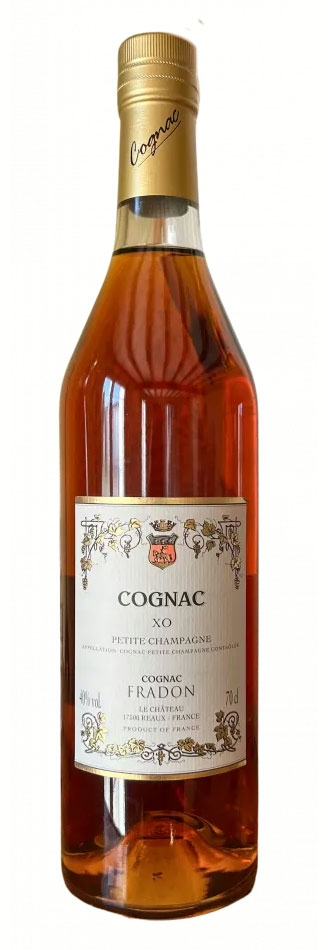My fifth Cognac sample from the Cognac Expert Advent Calendar 2024 is a Fradon XO Petite Champagne Cognac. Fradon’s history starts under another name, as Henri Chainier pioneered the bottling and commercialisation of Pineau des Charentes in the 1930s, a local aperitif that people only enjoyed within families at the time. In the 1950s, his daughter Denise married Marc Fradon, and the domain changed name to Fradon. In 1989, their son Michel took over the estate, expanding direct sales and welcoming visitors to the domain. Today, Damien, Henri’s great-grandson, carries on the family tradition. Whilst they used mostly Ugni Blanc grapes, they introduced the Folle Blanche grape to their production in 2003. Despite its lower yield, susceptibility to rot, and challenging vinification, it delivers exceptional eaux-de-vie that are refined, delicate, and intensely aromatic. Fradon‘’’s domain extends over 40 ha in the Petite Champagne region.
Obscuration and the Permitted Additives in Cognac
When I wrote my What is Cognac? long article a few days ago, I completely forgot to mention the fact that some additives are allowed in Cognac. So let’s talk about them here, as you’ll see below, the Fradon we’re reviewing today also uses one of the allowed additives, and I’ll update my long article about cognac as well.
The topic of additives in spirits, including Cognac, remains contentious yet significant for understanding production processes. Additives, while permitted in many spirits like Cognac, Scotch whisky, and rum, often provoke scepticism among enthusiasts. In Cognac, obscuration – a term describing the difference between gross and real alcoholic strength – quantifies the influence of additives. Official documentation such as the Cahier des Charges governs Cognac production but does not explicitly mention ‘additives’. Instead, it allows three specific categories of additives: caramel colouring (E150a), sugar (in various forms), and oak chip infusion (boisé). These are permitted provided the level of obscuration remains below 4% by volume.
Obscuration is determined by comparing the gross alcohol level (adjusted for temperature) to the real alcohol level, as verified by lab analysis. While additives like caramel, sugar, and boisé explain much of the obscuration, other factors inherent in Cognac contribute as well. For instance, even additive-free Cognac can display a small obscuration level due to natural complexities in the spirit. The controlled use of these additives enables producers to achieve desired flavour profiles, colour, and harmony without exceeding legal limits.
In terms of sugar content, Cognac’s additive levels are modest compared to other beverages, such as Champagne or Coca-Cola. For instance, Cognac might contain up to 16 g/L of sugar, whereas Sauternes and soft drinks far surpass this range. Beyond additives, water or petites eaux – water aged in barrels with low-alcohol eaux-de-vie – play a pivotal role in reducing Cognac’s alcohol level to meet bottling standards, often around 40% ABV.
Comparisons to other spirits reveal a range of practices. While Bourbon and mezcal prohibit additives, Scotch whisky allows caramel colouring, and tequila permits several, including glycerine and sugar-based syrups. Cognac’s approach balances tradition and modern production needs, maintaining strict oversight through regulatory frameworks.
Ultimately, discussions about additives are beneficial for transparency and consumer awareness, fostering a deeper appreciation of Cognac’s craftsmanship. Whether a Cognac contains additives or is bottled additive-free, its value lies in the skill of its production and the experience it delivers. The trend towards naturally presented spirits reflects a growing consumer preference for authenticity, yet additive-inclusive cognacs remain a valid expression of the craft. Both styles coexist as branches of the same tree, catering to diverse preferences across the Cognac spectrum.
Fradon XO Petite Champagne Cognac Review
Fradon XO is made from Ugni Blanc grapes and distilled with lees in a 20 hl still. Aged for 45 years in oak casks from Tonnellerie Jobit, using wide and fine grain wood with a heavy toast, it then rests in demijohns. A small amount of sugar is added before bottling at 40% ABV, with no other additives. Priced just above €100, it looks like very good value for a 45-year-old cognac!

Colour:
Auburn.
Nose:
Neat: Initially subdued, it takes time to open up. Subtle hints of rancio, faint traces of figs, and a touch of spice emerge, but even after 20 minutes and warming, that’s all it revealed.
Palate:
Neat: Initially reminiscent of yesterday’s Bache Gabrielsen due to its sweet arrival, but it evolves more swiftly, revealing notes of oak, dark chocolate, rich caramel, vanilla, floral hints, peach, apricot, and a touch of spice.
Finish:
Lingering spices are accompanied by caramel, a hint of wood, and a touch of vanilla. The finish is of medium length.
Comments:
Once again, I’m confident it would have been much better without added sugar and with a higher ABV, as these seem to have compromised both the palate and the nose. Even after half an hour, the nose remained exceptionally subdued—or perhaps it was simply that basic. Either way, this one doesn’t inspire me to seek out a bottle, and it might not offer the best value after all.



